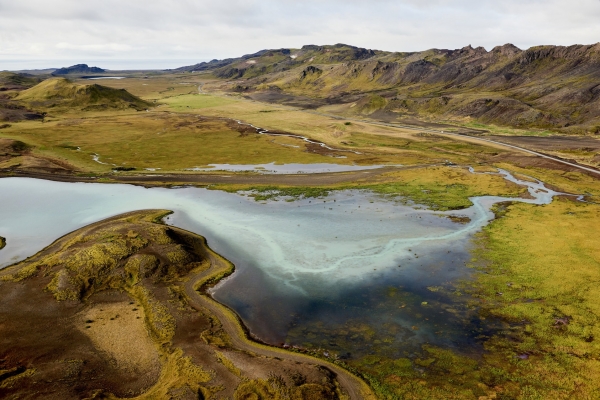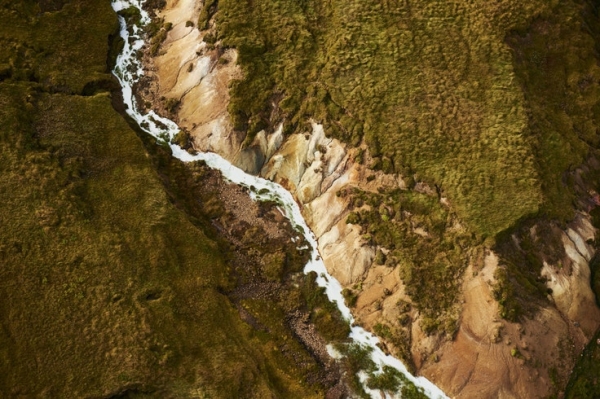A sharp earthquake was felt in the capital region yesterday evening when a sharp 4.1 magnitude quake hit south of Bláfjöll mountain range. A swarm of smaller tremors followed the larger quake, but scientists have not noticed a growing level of seismic og or other geological activity in the area. However, the volcanic and geothermal systems of Reykjanes peninsula have been showing signs of increasing activity in the past couple of years.
Read more: Growing levels of activity at all geothermal sites on Reykjanes peninsula
The Icelandic Meteorological Office picked up the quake at 20:17 yesterday evening. Its epicenter was 6.2 km (3.9 mi) south of Bláfjallaskáli cabin in the Bláfjöll mountain range at a depth of 4.5 km (2.8 mi). Fifteen other smaller tremors have been detected since yesterday. The mountains are a popular recreational area during winter, as the ski area of Reykjavík is located in Bláfjöll.
Recent activity on Reykjanes
Reykjanes peninsula is one of the most geologically active areas in Iceland, and earthquakes are very common in the area. Last year geologists reported that geothermal areas on Reykjanes had been showing clear signs of increasing activity. Recently locals noticed that a small river which carries water from one of the geothermal sites around Kleifarvatn lake had turned color. The stream now carries blueish white silica rich water to the lake, coloring the southern part of Kleifarvatn white.
The water level in the hot spring Austur Engeyjarhver south of Kleifarvatn appears to have increased dramatically this summer, possibly due to the unusually wet weather this year.
At the end of August the IMO issued a warning advising divers to show extreme caution when diving in Kleifarvatn, as new geothermal vents have opened on the floor of the lake. A diver discovered a crater, ten meters across (33 ft), which appeared to be spewing hot water into the lake. Geologists who spoke to the National Broadcasting Service believe the geothermal activity is linked to an intense earthquake swarm in the area on July 31.

Southern tip of Kleifarvatn The silica rich geothermal water colors the lake. Photo/Haraldur Diego

The stream The small creek which carries water from Austur Engeyjarhver has turned blueish white. Photo/Haraldur Diego
A sharp earthquake was felt in the capital region yesterday evening when a sharp 4.1 magnitude quake hit south of Bláfjöll mountain range. A swarm of smaller tremors followed the larger quake, but scientists have not noticed a growing level of seismic og or other geological activity in the area. However, the volcanic and geothermal systems of Reykjanes peninsula have been showing signs of increasing activity in the past couple of years.
Read more: Growing levels of activity at all geothermal sites on Reykjanes peninsula
The Icelandic Meteorological Office picked up the quake at 20:17 yesterday evening. Its epicenter was 6.2 km (3.9 mi) south of Bláfjallaskáli cabin in the Bláfjöll mountain range at a depth of 4.5 km (2.8 mi). Fifteen other smaller tremors have been detected since yesterday. The mountains are a popular recreational area during winter, as the ski area of Reykjavík is located in Bláfjöll.
Recent activity on Reykjanes
Reykjanes peninsula is one of the most geologically active areas in Iceland, and earthquakes are very common in the area. Last year geologists reported that geothermal areas on Reykjanes had been showing clear signs of increasing activity. Recently locals noticed that a small river which carries water from one of the geothermal sites around Kleifarvatn lake had turned color. The stream now carries blueish white silica rich water to the lake, coloring the southern part of Kleifarvatn white.
The water level in the hot spring Austur Engeyjarhver south of Kleifarvatn appears to have increased dramatically this summer, possibly due to the unusually wet weather this year.
At the end of August the IMO issued a warning advising divers to show extreme caution when diving in Kleifarvatn, as new geothermal vents have opened on the floor of the lake. A diver discovered a crater, ten meters across (33 ft), which appeared to be spewing hot water into the lake. Geologists who spoke to the National Broadcasting Service believe the geothermal activity is linked to an intense earthquake swarm in the area on July 31.

Southern tip of Kleifarvatn The silica rich geothermal water colors the lake. Photo/Haraldur Diego

The stream The small creek which carries water from Austur Engeyjarhver has turned blueish white. Photo/Haraldur Diego







